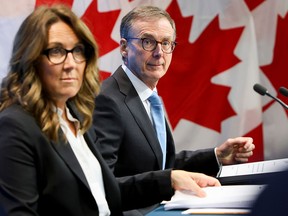Canada’s government debt load ‘uncomfortably high,’ and fiscal austerity may be needed as soon as mid-decade
Article content
In its latest two-year outlook, Hope at Last, the Conference Board of Canada anticipates Canadian GDP will expand 5.8 per cent in 2021 and 4 per cent in 2022. TD Bank Group also raised its forecast for the GDP to grow to around 6 per cent this year on Tuesday, while earlier this month, Royal Bank of Canada had upgraded its estimate for the Canadian economy to 6.3 per cent this year, from 5 per cent previously.
“We’ve had an economy that’s lost about 5.4 per cent of its GDP, its income generation, in 2020,” Pedro Antunes, chief economist at the Conference Board, told the Financial Post in an interview. “And we’ve essentially infused support and other measures… worth probably around 15 per cent of GDP. So, we’ve borrowed that much to put back into the hands of households and consumers.”
Article content
In the report, Antunes said despite the economic rebound, Canada’s government debt load has become “uncomfortably high,” and might necessitate fiscal austerity as soon as mid-decade, which could restrain the country’s future growth prospects.
“I do think governments need to start thinking about this and planning forward,” he said. “I mean, will we see something in the federal budget that speaks to the longer-term challenges? Because there’s some very real challenges that we’re going to be left with here.”
I do think governments need to start thinking about this and planning forward
Pedro Antunes, chief economist, Conference Board of Canada
The federal government is set to unveil its first budget in two years on April 19.
Canada’s debt-to-GDP ratio now stands at more than 100 per cent, and the federal government has set aside another $70 billion to $100 billion of additional stimulus, to repair the economy after a COVID-induced recession last year.
But these expenses will need to be paid for.
“Right now, nobody wants to talk about it because nobody wants to impose tax measures or fiscal austerity at a time when the economy is still such in such bad shape,” Antunes said. “But I do think governments need to start thinking about this and planning forward.”
Article content
After that, the recovery will hinge on public health and vaccination programs. Antunes said his projections count on the pandemic being largely over in Canada by fall. Prime Minister Justin Trudeau has set a target for every Canadian to have access to the vaccines by September.
RBC economists Craig Wright, Dawn Desjardins and Nathan Janzen revised their growth projections upwards for every province, partly because mass vaccinations are now on the horizon.

“The projected rise in vaccinations will allow restrictions to be eased and eventually eliminated clearing the path for spending on services to bounce back in the second half of 2021,” RBC said in its report. “Government support for unemployed workers will continue in 2021 though demand will decline over the course of the year as the economy reopens and workers are rehired.”
Canadians have increased their savings dramatically, but analysts believe it is difficult to predict whether those savings will translate into pent-up consumer demand. RBC estimates households’ stockpiled around $200 billion in excess savings last year.
Conference Board’s Antunes said the savings rate could be good news: “Either way you look at it, it’s not bad for you to have households have a little bit more reserves in their savings,” he said. “We were very concerned about households up until 2020, about how low the aggregate savings rate was.”
Canadian GDP set to surge this year, but high debt levels could crimp future growth prospects
2021-03-30 21:14:17





